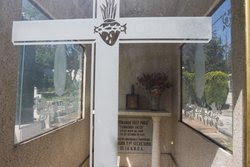1894-1956
John Florence Sullivan was born in Cambridge, Mass to a staunch Irish family. His mother died when he was only 3 years old and the family (Allen, dad and infant brother Robert) had to move in with one of his mother's sisters, who had a disabled husband. Allen later remembered these hard times in a second memoir that he would pen; both his father (due to drinking) and his uncle (due to lead poisoning) could not work. Eventually, his father remarried and things stabilized for the two boys. Both boys were offered the chance to go with him and his new wife, or to stay with their aunt--Allen chose the latter; later saying that he had not one single regret for doing so. One thing that did come of the family moving into such close quarters, is that his father purchased a Emerson upright piano when they moved--Allen took piano lessons, but only managed to learn two songs. It was, however, the beginnings of his performance exposure. When older, he took a job at the Boston Public Library and found a book on the origins and development of comedy that was hugely influential on him. To help with family money troubles, he also took up juggling. As fate would have it, the library decided to put on a stage show for patrons and asked him to do some juggling and a bit of comedy. A young girl in the audience liked his routine so much that she told him he shouldn't be a library employee--he should be on the stage! He determined that this is what he wanted to do with his life, but it took some time to realize. In 1914, at the age of 20, in addition to his library work, he added working in a piano repair shop to his daytime work, and taking parts in amateur stage competitions to his night time activities. At first, he took the stage name of Fred St. James and soon found himself on a $30 a week vaudeville circuit. This then morphed into "Freddy James: World's Worst Juggler." He went out on wider and wider traveling vaudeville shows. In 1917, he returned to New York and substituted the last name "Allen" after a booker for Fox theaters (not Edgar Allan Poe, as has been suggested) so that he would be paid more by theater owners--had they billed him under his original name, he was sure to get a lower salary. Throughout the 1920's he continued to develop his stage act, including a few truly original and bizarre touches (a cemetery gag amongst them). He made his Broadway debut in 1922; he then gravitated to early radio. In the 1920's radio was beginning to really show it's promise with staged shows being broadcast to a growing audience that no longer had to pay up to attend live shows in theaters. The radio work then led to two short film appearances in 1929, both were early talkies. The first was The Installment Collector, a ten minute comedy voice-over featuring Allen talking a mile an hour (a contrast from his later radio persona, for which he is best known); the second is Fred Allen's Prize Playlets (1929), and even shorter film featuring some of his fellow radio players. The first was produced by Paramount, the second by Warner Bros. Both are in mono. If you look up Allen's film credits, they are quite short--just a little over 10 appearances; however his radio work, which began full time in 1932, was extensive! In fact, one of his shows featured bogus news desk coverage, something that everyone from the likes of Johnny Carson to Lorne Michael's of Saturday Night Live, would go on to imitate. To read more about his immense radio career, please see the Wikipedia link below. Starting in 1953, he was a panelist on the popular television program What's My Line--his comedy was then introduced to a whole new generation of people. On the 17 of March in 1956 he suffered a shift and fatal heart attack, much to the shock of everyone who knew him. His wife insisted that Fred would have wanted the show to go on as planned--remember, this is when television was live--so Steve Allen took his place on Line and the panel proceeded as usual, until the last 90 seconds of the broadcast, when everyone offered their fondest memories of Fred Allen. He is buried in the Gate of Heaven Cemetery in Hawthorn, New York. Both his birth name and the name that the rest of world knew him by are engraved on his marble marker. He was 61 years of age at the time of his death.
Leave Virtual Flowers at Find A Grave

































